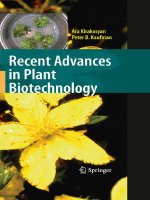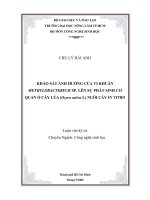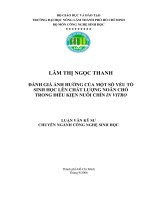Enzymic browning in potatoes
Bạn đang xem bản rút gọn của tài liệu. Xem và tải ngay bản đầy đủ của tài liệu tại đây (149.01 KB, 3 trang )
* E-mail:
Biochemical Education 27 (1999) 171}173
Enzymic browning in potatoes: a simple assay for a polyphenol
oxidase catalysed reaction
J.M. Busch*
Animal and Food Sciences Division, Lincoln University, P.O. Box 84, Canterbury, New Zealand
Abstract
A simple laboratory procedure is described for demonstrating the enzyme-catalysed reaction in the browning of potato. It requires
a minimum of equipment and can be completed in a 3-h lab class. 1999 IUBMB. Published by Elsevier Science Ltd. All rights
reserved.
1. Introduction
This paper describes a student laboratory procedure
designed to show the enzyme-catalysed reaction resulting
in the browning of raw potato. Although several methods
are available for recording enzymic browning in plants,
they generally require the use of toxic chemicals (phenol)
or expensive equipment (eg. spectrophotometers and
oxygen electrodes) [1,2]. This method allows students to
demonstrate enzymic browning in a semi-quantitative
way using non-toxic chemicals. It can be completed in
a 3-h laboratory class.
For two years the basic experiment plus the problem
solving exercises have been used as the basis on which
food biochemistry students in our institution develop an
experimental design to show the extent of enzymic
browning in a particular potato cultivar. They have also
developed feasible procedures that could be used by food
industries to prevent enzymic browning. These students
have reported favourably on this application of a simple
practical experiment to problem solving in real-life situ-
ations in the food industry [3].
2. Background
Many fruits and vegetables turn brown when cut
or damaged surfaces are exposed to the air, with the
reaction showing most clearly on light-coloured #esh.
This browning occurs due to the oxidation and dehyd-
rogenation of colourless polyphenols present in the
plants. The initial reaction catalysed by polyphenol
oxidase and produces reddish-brown o-quinones. These
are highly reactive, and so they subsequently undergo
a series of non-enzymic reactions [4,5] to yield insoluble
black}brown melanin pigments (Fig. 1).
Polyphenol oxidase is a very important enzyme for
food chemists and processors because its action leads to
major economic losses in fresh fruits and vegetables such
as potatoes, lettuce and other leafy vegetables, apples,
grapes, bananas and many tropical fruits [6]. Up to
one-half of some tropical fresh fruits are lost because of
browning [7]. Potential purchasers show consumer res-
istance to the dark colour of the damaged products, the
o!-tastes in juices and vegetables, and the resulting cha-
nges in texture. This reaction is, however, exploited in the
fermentation of tea leaves, co!ee beans, cocoa and
tobacco, and in the colour of dried prunes, dates and
raisins [7].
The enzyme is located in the plastids of plant cells and
the phenolic substrates are stored in the vacuoles. This
physical separation prevents any oxidation of the phen-
olics in the undamaged living tissues [3]. The separation
can be lost as a result of damage to the cell during
harvesting (unintentional) and processing (intentional).
Oxidation of the phenolics by polyphenol oxidase (PPO)
then begins.
The functions of PPOs in higher plants are not fully
known but they are thought to play a key part in the
plant's defence mechanism against disease causing
micro-organisms and insect attack [7]. When microbial
0307-4412/99/$20.00#000 1999 IUBMB. Published by Elsevier Science Ltd. All rights reserved.
PII: S 0 3 0 7 - 4 4 1 2 ( 9 9 ) 0 0 0 3 3 - 3
Fig. 1. The chemical reactions involved in browning.
infection occurs the cell integrity is broken and the
enzymic reaction takes place. An impervious scab of
melanin forms and this acts as a physical anti-microbial
barrier [3]. The quinones formed during the reaction are
known to denature proteins in the invading microorgan-
isms and the polymeric phenols complexes can act as
inhibitors of microbial growth [3].
3. Method
Four 5 mm slices are cut with a knife, across the short
axis of each washed but unpeeled potato (two blanks and
two test slices). Slices are placed in individual Petri dishes
and 100 l of control bu!er (0.1 M Tris-HCl/0.02%w/v
SDS, pH 9.0) is spread over the whole surface of the
blank slices using a hockey stick (a right-angled piece of
glass rod). Substrate solution (100 l of 0.01 M disodium
tyrosine/0.1 M Tris-HCl/0.02%w/v SDS, pH 9.0) is
spread over the test slices. Lids are placed on the Petri
dishes to minimise evaporation. All slices are incubated
at 303C for 1 h before being examined for a black deposit
of melanin. If the slices need to be kept for another
laboratory session they must be placed in a freezer be-
cause the enzyme remains active at low temperatures.
The resulting area of black melanins on each slice can
be ranked from 1 to 5, with &1' indicating no discolour-
ation and &5' representing total discolouration of the slice.
Alternatively, the darkening of a representative number
of 1 cm
squares of a slice can be calculated using a 1 cm
template overlay. Each square that is completely black is
counted and recorded as a percentage of the total num-
ber of complete squares covered by the template. This
method is adapted from the Speck Test for wheat cul-
tivars [8]. A colour meter (e.g. Minolta chroma meter
CR-210) can also be used to measure the colour of the
slices.
4. Discussion
The black colour can occur all over the slice and/or in
a ring about 5 mm inside the skin of the potato or in
ade"ned semi-circular area out from the skin. In this case
it usually re#ects mechanical damage (knocks and
bruises) from rough handling since harvest. Some potato
slices can show a pink colour instead of black. This pink
colour is due to an o-quinone, an intermediate in the
complete conversion to melanins. Allowing more time
will let the reaction go to completion. The control slices
show no colour change. The photograph shows a typical
result (Fig. 2). It is important to note that there is con-
siderable variation in the results obtained with this test
and there are several reasons for this.
Studies have shown that both the degree of darkening
and the rate of darkening vary considerably from one
potato variety to another, depending on the age and
maturity of the potato as well as on the availability and
levels of substrate [5,6,9]. The e$ciency of treatment to
prevent melanin formation can vary according on the
nature and concentration of inhibitor, sources of oxygen
and substrate availability, pH and temperature [3].
These inherent variations mean that no one treatment is
successful all the time so processors have to resort to
chemical as well as physical means to prevent enzymic
browning, even when using recommended &&non-
browning'' commercial varieties of potatoes [10]. In po-
tatoes, internal discolouration is of major concern to
growers and processors due to the increased labour costs
for sorting blemished and damaged tubers and the cost of
preventing browning during processing [10]. Scientists in
the food industry are currently investigating innovative
ways to control or inhibit enzymic browning in foods (eg.
gene manipulation for low polyphenol oxidase content of
potatoes) [9].
5. Experiments based on this simple test
The types of treatments used can be divided into two
broad types, chemical and mechanical.
Chemical: Students can design experiments to show
the e!ect of using chemical treatments to prevent en-
zymic browning by trying any of the following pre-treat-
ments: 100 l 4% citric acid, 100 l 4% ascorbic
acid,100 l 2% cysteine, 100 l 1% sodium acid pyro-
phosphate or 100 l 0.5% sodium bisulphite. The treat-
ment chemical is applied to the potato slice and allowed
to soak in before the substrate is added. Students need to
be aware that any chemicals used need to be non-toxic
and have no e!ect on the taste, #avour, texture and
wholesomeness of the "nal product [3].
Mechanical: Students can use this procedure to inves-
tigate the following questions: Do di!erent potato
172 J.M. Busch / Biochemical Education 27 (1999) 171}173
Fig. 2. Results for a control (left) and test (right) slice of potato.
cultivars have browning di!erences? Do commercially
harvested potatoes show higher levels of browning than
hand harvested potatoes? Does storing potatoes for dif-
ferent lengths of time (days or weeks) have an e!ect on
the browning? Does storage temperature have an e!ect
on browning? Does blanching the potato slices a!ect the
browning? Does covering the potato slices with cling-
wrap a!ect the level of browning?
6. Case studies
(1) Students could investigate which industries are a!ec-
ted either positively or negatively by this reaction (e.g.
wine, fruit, grain or vegetable, including the pre-
peeled potato industry).
(2) Students could determine the feasibility of developing
a test that could be used for quality control before
purchase to ascertain whether plants have been
damaged during harvest or transport to the factory.
Such a test would need to be economically feasible.
(3) Student could search the published literature to
review what work has been done to breed plants,
either by conventional plant breeding or gene manip-
ulation, which have low levels of polyphenol oxidases
[9].
7. Conclusions
The laboratory method described here can be used to
as the basis for a number of other experiments to increase
the students' understanding not only of how enzymes
function, but also how this information can be applied
practically in the food industry.
References
[1] C.W. Wrigley, Single-seed identi"cation of wheat varities: use
of grain hardness testing, electrophoretic analysis and a rapid
test paper for phenol reaction, J. Sci. Food Agric. 27 (1976)
429}432.
[2] D.R. Marsh, T. Galliard, Measurement of polyphenol oxidase
activity in wheat-milling fractions, J. Cereal Sci. 4 (1986)
241}248.
[3] J. Zawistowski, C.G. Biliaderis, N.A.M. Eskin, In D.S. Robinson,
N.A.M. Eskin (Editors), Oxidative Enzymes in Food, Elsevier
Science, New York, 1991.
[4] M A. Rouet-Mayer, J. Ralambosoa, J. Phipippon, Phytochemis-
try 29 (1990) 2.
[5] J.R. Whitaker, C.Y. Lee, Enzymatic Browning and its Preven-
tion, ACS Symposium Series Vol. 600, Washington, (1995)
pp. 3}7.
[6] J.R. Whitaker, in: O. Fennama (Ed.), Food Chemistry, 3rd ed.
Marcel Dekker, New York, 1996, pp. 431}530.
[7] J.R.L. Walker, Enzymatic Browning and its Prevention, ACS
Symposium Series,Vol. 600, Washington, 1995, pp. 8}22.
[8] J.M. Busch, R.L. Hay, S.E. Holst, T.N. Lindley, M.P. Newberry,
Proc. RACI Cereal Chemistry Division Conf. Adelaide, Australia,
1995, pp. 303}306.
[9] C.W.B. Bachem, G J. Speckman, P.C.G. Van der Linde, F.T.M.
Verheggen, M.D. Hunt, J.C. Ste!ens, M. Zabeau, J. Bio/technol.
(1994) 1101}1105.
[10] I.R. Gubb, J.C. Hughes, M.T. Jackson, J.A. Callow, Ann. Appl.
Biol. 114 (1989) 579}586.
J.M. Busch / Biochemical Education 27 (1999) 171}173 173









